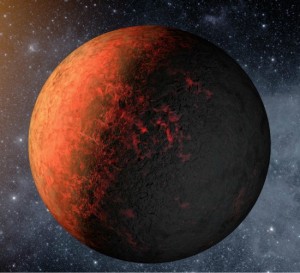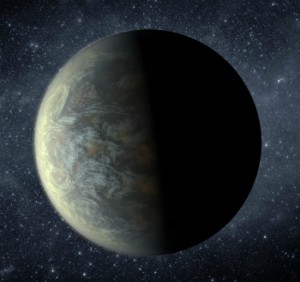What the Earth-Sized Planet Discovery Means
The lead scientist in the new planet discovery explains the significance of the find
/https://tf-cmsv2-smithsonianmag-media.s3.amazonaws.com/filer/20111221022005planet-line-up-small.jpg)
Yesterday, scientists at the Smithsonian Astrophysical Observatory in Cambridge, Massachusetts made a major announcement. For the first time, after years of searching, Earth-sized planets had been detected outside of our solar system. Among the five planets in the distant Kepler-20 star system are Kepler-20e and Kepler-20f—two rocky orbs with diameters approximately 87 percent and 103 percent that of earth, respectively. The news has the scientific world in a state of excitement over the consequences of the find. We spoke with Smithsonian astrophysicist Francois Fressin, the lead author of the paper, about the discovery.
The Basics
Researchers have been using the Kepler space telescope since it launched in March of 2009 to search for exoplanets, or planets in other solar systems. “Kepler is staring at 200,000 stars, all located in the same area of the sky, and it just monitors the light it gets from each of the stars, continuously, for years,” says Fressin. “For a fraction of the stars, there’s a periodic dimming with the same duration and same depth of light.” This dimming can be caused by a small opaque body crossing between the star and the telescope—in this case, a pair of planets. The team first detected the telltale dimming more than a year ago, but had to make more calculations with custom-developed software to rule out the possibility that it was caused by other phenomena.
From the degree and frequency of the dimming, the scientists are able to make inferences about the planets. Kepler-20e and Kepler-20f are 6,900 miles and 8,200 miles in diameter, respectively, remarkably close to Earth’s 8,000 mile size. Because the two planets are so close to their host star—they orbit at 4.7 million miles and 10.3 million miles, both far closer in than Mercury is to the sun—they are believed to be extremely hot, with average temperatures of 1400 and 800 degrees Fahrenheit, respectively. “We know they’re both pure rock bodies,” Fressin says. “But we don’t have precise mass estimates, so we can’t say if they’re similar in composition to the Earth, or something denser with more iron, like Mercury.”
What It Means For Astronomy
Exoplanet hunters began uncovering distant gas giants as early as 1992, but smaller, Earth-sized bodies had proved more difficult to detect. “We’ve crossed the threshold: this the first time that humanity is able to detect an Earth-sized object around another star,” Fressin says. ”That’s symbolically and technologically important.”
The discovery represents a historic milestone in astronomy. Now, scientists are convinced that they have the right tools to be able to detect Earth-sized planets that might support life. Researchers will continue using the Kepler space telescope to locate exoplanets in hope of finding such a world.
What It Means For Planetary Science
The discovery also turns upside-down much of what scientists believed about the formation of solar systems. The two Earth-size planets are interspersed with three gas giants, all extremely close to the host star, Kepler-20. “From the star, it goes in the order big, small, big, small, big, which seems completely weird,” says Fressin. “In our solar system, we have these four rocky small bodies, and then, farther away, these four large giant gaseous planets. So how did that happen, that we have all this mixing in the Kepler-20 system?”
Although we don’t currently have definitive answers, scientists suspect that the planets drifted into their current position over time. “They didn’t form at the place they are right now, there was not enough rocky material to build these five planets so close to their host star,” Fressin says. “So one solution would be that they formed farther out, and then migrated in.”
What It Means For Extraterrestrial Life
The most tantalizing possibility of these discoveries is the potential that the exoplanets might harbor life. But both Kepler-20e and Kepler-20f are outside the habitable zone—often called the “Goldilocks” zone—that is neither too close nor too far from the host star, allowing for the evolution of living creatures. ”We don’t know a lot of things about life, but we know that one of the main ingredients of life on Earth is the presence of liquid water,” says Fressin. “Right now, at the temperatures estimated, water can’t be in a liquid state on either planet.”
Still, the hypothesis that the planets may have formed farther away, and then migrated to their current locations close to the star, means that life may have existed long ago. “It seems pretty clear that Kepler-20f once crossed the habitable zone of its host star, after its formation,” Fressin says. “It is the closest object in terms of size to the Earth in the known universe, and this means that it could have been habitable in its past.”
What It Means For Space Exploration
Although Kepler-20 is much too far to attempt as the target of a space probe mission—it’s about 950 light-years from Earth, which would require a journey of 36 million years by the space shuttle—Fressin feels that discoveries like this should stimulate interest in the very real possibility of exploring other, closer, star systems. “It would be challenging, and would require great international collaboration, maybe for one or two generations, but it would be feasible,” he says.
Such a mission would admittedly be very long-term, but the rewards are many. “I think the best location to send a probe would be to the closest sun-like star,” says Fressin. “So then imagine, in two generations, we’d have the probe coming back with pictures—real pictures—of another world.”
/https://tf-cmsv2-smithsonianmag-media.s3.amazonaws.com/accounts/headshot/joseph-stromberg-240.jpg)


/https://tf-cmsv2-smithsonianmag-media.s3.amazonaws.com/accounts/headshot/joseph-stromberg-240.jpg)